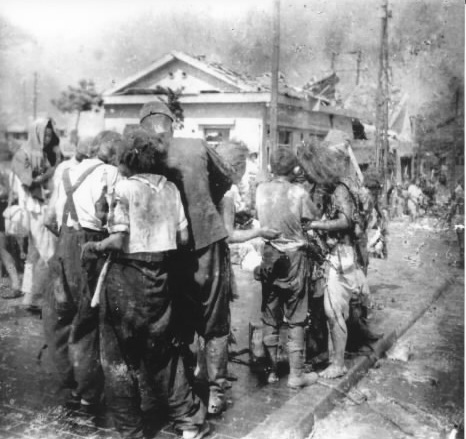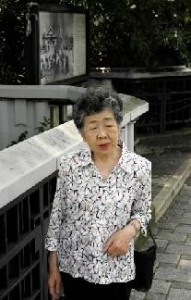Images of the Atomic Bombing, 1945~2007, Part 5
Jun. 27, 2010
Hellish scene at Miyuki Bridge
by Masami Nishimoto, Senior Staff Writer
What were the consequences of the atomic bombing of Hiroshima? What consequences continue to linger on? This series [originally published in August 2007] traces the people linked to photographs which record the A-bomb devastation. With some voices in Japan now contending that the nation should arm itself with nuclear weapons, it is time to stress the reality of the destruction these weapons wreak.
The future depends on remembering the past
Yoshito Matsushige took this photo at around 11 a.m. on August 6, 1945 at Miyuki Bridge, located 2.2 kilometers southeast of the hypocenter. Mr. Matsushige, a former photographer for the Chugoku Shimbun who died in 2005 at the age 92, also served as a reporter for the Chugoku District Military Headquarters and took five photos of the misery of Hiroshima citizens on the day of the atomic bombing. Hesitating, he finally pressed the shutter for this shot which eventually became an invaluable depiction of the city's devastation for the outside world.
The girl in the sailor-type school uniform, with her back to the camera, was a mobilized student, 13 years old at the time. She stands behind a man in uniform, applying oil to a civilian with severe burns on his upper body. That civilian, whose head and right arm are showing over the right shoulder of the man in uniform, is the girl's father.
The back of the girl's uniform is darkened by blood stains from the wounds of glass fragments that have pierced her body. Mitsuko Kouchi, whose maiden name was Sakamoto, is now 75 and she revealed details of her experience that day when she and her father were photographed on the Miyuki Bridge.
Ms. Kouchi was in her second year at Hiroshima Girls Commercial High School in 1945. In support of the war effort, she had been assigned to work at the Postal Savings Bureau Hiroshima Branch in Senda-machi, 1.6 kilometers southeast of the hypocenter.
"I see a B-29," she said to a friend nonchalantly after spotting a U.S. B-29 bomber from the second floor window of the office where she worked. Seated at her desk, she was suddenly blown into the air by the blast. Regaining consciousness, she managed to crawl out of the wreckage of the building. Then she heard a voice calling her name: "Mitsuko Sakamoto, are you here?" It was her father Gisabro, searching for her. Gisabro died in 1966 at the age of 75.
Gisaburo, a carpenter, had been doing some repair work that day at a hospital in Senda-machi. He was so severely burned in the blast that he could only be identified by the sound of his voice. Father and daughter, along with five of Ms. Kouchi's friends, headed north for Hiroshima City Hall. They were stunned at the hellish sight, encountered everywhere, of "people with their hair standing on end and their skin peeling off."
They changed course, heading south to Shudo High School via Hiroshima Technical Institute. Along the way they noticed that they were all barefoot. "The ground was hot and our feet hurt walking over the rubble" so she picked up a pair of sneakers on the riverbank and proceeded in the direction of Miyuki Bridge. At the bridge they came across the man who was dabbing cooking oil on the injured.
"There was a continuous line of people waiting," Ms. Kouchi recalled. "I joined the line with my father so he could be treated with the oil."
The photographer, Yoshito Matsushige, then 32, happened to be there. Mr. Matsushige once said: "I pressed the shutter from behind the people who had fled to the bridge for safety. I took one shot, two shots, then I went around to shoot them from the front. But they looked to be in so much pain…" He could not bring himself to take any more photos at the scene.
Seeing the first image taken at Miyuki Bridge, Ms. Kouchi summoned her memories and shared her story. "The woman to my left was pacing madly in a circle, crying out the name of the dead child in her arms. It was all so awful," Ms. Kouchi murmured.
The daughter led her father across two rivers and arrived at Funairi Miyuki-machi in Naka Ward. They found the charred body of her mother Fumie, then 46, at the site where their home had stood. After locating her younger brother, the three spent that night in a fig tree orchard. The next day they fled toward Koi, to the west of the A-bombed city, walking along the streetcar tracks through land that had become a vast site for cremating the dead.
Twenty-eight years after the bombing, Ms. Kouchi first publicly admitted to being the girl in the sailor-suit uniform. The uniform had been handed down from her cousin. She was inspired to step forward when the photo was displayed in an exhibition held at Hiroshima Peace Memorial Museum.
By revealing her identity, Ms. Kouchi was hoping to obtain a copy of the photo which testified to the day spent with her late father. Suddenly, though, TV crews were converging on her home. She received a copy of the image from Mr. Matsushige and rejoiced over the "reunion" with her father, but since then had avoided further media coverage.
A remark made by her son--"You don't have to hide"--finally persuaded her to accept the media's attention. Her three grandchildren are now old enough, too, to understand the implications of the photo.
"I was able to survive," Ms. Kouchi said, "so I could be blessed with grandchildren and speak to you like this today. If nuclear weapons were to be used now, weapons that are many times more powerful than the atomic bombs, there would be no survivors. I would like people everywhere to see my photo and understand the horror of these weapons."
The future of the human race, she says, depends on remembering the misery that occurred on Miyuki Bridge.
(Originally published on August 14, 2007)









